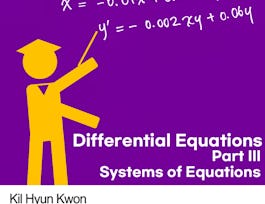This course continues your study of calculus by introducing the notions of series, sequences, and integration. These foundational tools allow us to develop the theory and applications of the second major tool of calculus: the integral. Rather than measure rates of change, the integral provides a means for measuring the accumulation of a quantity over some interval of input values. This notion of accumulation can be applied to different quantities, including money, populations, weight, area, volume, and air pollutants. The concepts in this course apply to many other disciplines outside of traditional mathematics. Through projects, we will apply the tools of this course to analyze and model real world data, and from that analysis give critiques of policy.


Calculus through Data & Modelling: Series and Integration
This course is part of Integral Calculus through Data and Modeling Specialization
Taught in English
Some content may not be translated

Instructor: Joseph W. Cutrone, PhD
Top Instructor
4,272 already enrolled
Included with 
Course
(35 reviews)
Details to know

Add to your LinkedIn profile
6 quizzes
Course
(35 reviews)
See how employees at top companies are mastering in-demand skills

Build your subject-matter expertise
- Learn new concepts from industry experts
- Gain a foundational understanding of a subject or tool
- Develop job-relevant skills with hands-on projects
- Earn a shareable career certificate


Earn a career certificate
Add this credential to your LinkedIn profile, resume, or CV
Share it on social media and in your performance review

There are 5 modules in this course
Calculus is divided into two halves: differentiation and integration. In this module, we introduce the process of integration. First we will see how the definite integral can be used to find the area under the graph of a curve. Then, we will investigate how differentiation and integration are inverses of each other, through the Fundamental Theorem of Calculus. Finally, we will learn about the indefinite integral, and use some strategies for computing integrals.
What's included
3 videos1 reading1 quiz
In this module, we introduce the notion of Riemann Sums. In mathematics, a Riemann sum is a certain kind of approximation of an integral by a finite sum, named after nineteenth century German mathematician Bernhard Riemann. One very common application is approximating the area of functions or lines on a graph, but also the length of curves and other approximations. This notion of approximating the accumulation of area under a group will lead to the concept of the definite integral, and the many applications that follow.
What's included
5 videos1 reading1 quiz
We now introduce the first major tool of our studies, the Fundamental Theorem of Calculus. This deep theorem links the concept of differentiating a function with the concept of integrating a function. The theorem will consists of two parts, the first of which implies the existence of antiderivatives for continuous functions and the second of which plays a larger role in practical applications. The beauty and practicality of this theorem allows us to avoid numerical integration to compute integrals, thus providing a better numerical accuracy.
What's included
2 videos1 reading1 quiz
In this module, we focus on developing our ability to find antiderivatives, or more generally, families of antiderivatives. In calculus, the general family of antiderivatives is denoted with an indefinite integral, and the process of solving for antiderivatives is called antidifferentiation. This is the opposite of differentiation and completes our knowledge of the two major tools of calculus. Antiderivatives are related to definite integrals through the fundamental theorem of calculus: the definite integral of a function over an interval is equal to the difference between the values of an antiderivative evaluated at the endpoints of the interval.
What's included
5 videos2 readings2 quizzes
While the technique of finding antiderivatives is useful, there are some functions that are just too difficult to find antiderivatives for. In cases like these, we want to have a numerical method to approximate the definite integral. In this module, we introduce two techniques for solving complicated integrals: using technology or tables of integrals, as well as estimation techniques. We then apply our knowledge to analyze strategies and decision theory as applied to random events.
What's included
1 video1 reading1 quiz1 peer review
Instructor

Offered by
Recommended if you're interested in Math and Logic

Johns Hopkins University

Johns Hopkins University

Johns Hopkins University

Korea Advanced Institute of Science and Technology(KAIST)
Why people choose Coursera for their career




Learner reviews
Showing 3 of 35
35 reviews
- 5 stars
94.28%
- 4 stars
5.71%
- 3 stars
0%
- 2 stars
0%
- 1 star
0%

Open new doors with Coursera Plus
Unlimited access to 7,000+ world-class courses, hands-on projects, and job-ready certificate programs - all included in your subscription
Advance your career with an online degree
Earn a degree from world-class universities - 100% online
Join over 3,400 global companies that choose Coursera for Business
Upskill your employees to excel in the digital economy
Frequently asked questions
Access to lectures and assignments depends on your type of enrollment. If you take a course in audit mode, you will be able to see most course materials for free. To access graded assignments and to earn a Certificate, you will need to purchase the Certificate experience, during or after your audit. If you don't see the audit option:
The course may not offer an audit option. You can try a Free Trial instead, or apply for Financial Aid.
The course may offer 'Full Course, No Certificate' instead. This option lets you see all course materials, submit required assessments, and get a final grade. This also means that you will not be able to purchase a Certificate experience.
When you enroll in the course, you get access to all of the courses in the Specialization, and you earn a certificate when you complete the work. Your electronic Certificate will be added to your Accomplishments page - from there, you can print your Certificate or add it to your LinkedIn profile. If you only want to read and view the course content, you can audit the course for free.
If you subscribed, you get a 7-day free trial during which you can cancel at no penalty. After that, we don’t give refunds, but you can cancel your subscription at any time. See our full refund policy.

